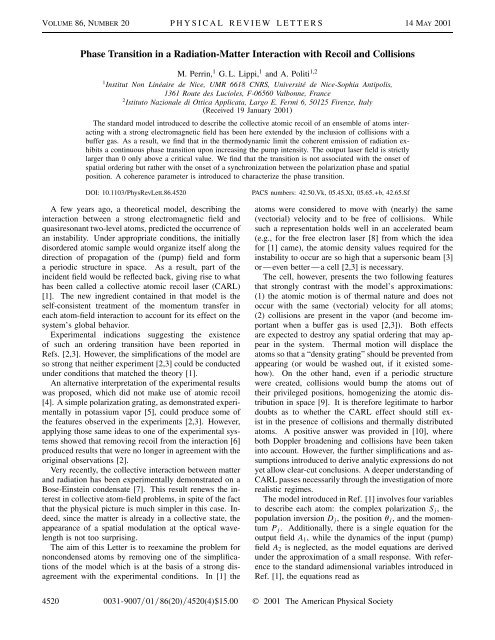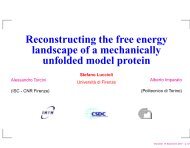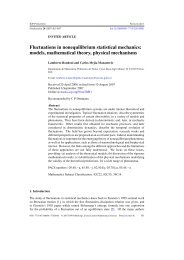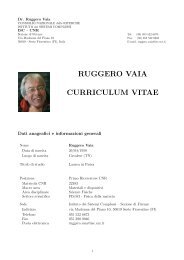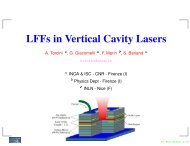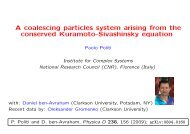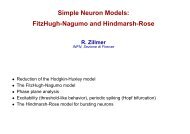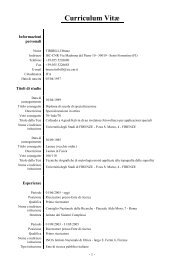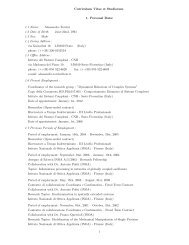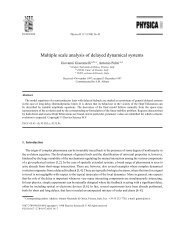Phase Transition in a Radiation-Matter Interaction with Recoil ... - ISC
Phase Transition in a Radiation-Matter Interaction with Recoil ... - ISC
Phase Transition in a Radiation-Matter Interaction with Recoil ... - ISC
You also want an ePaper? Increase the reach of your titles
YUMPU automatically turns print PDFs into web optimized ePapers that Google loves.
VOLUME 86, NUMBER 20 PHYSICAL REVIEW LETTERS 14MAY 2001<br />
<strong>Phase</strong> <strong>Transition</strong> <strong>in</strong> a <strong>Radiation</strong>-<strong>Matter</strong> <strong>Interaction</strong> <strong>with</strong> <strong>Recoil</strong> and Collisions<br />
M. Perr<strong>in</strong>, 1 G. L. Lippi, 1 and A. Politi1,2 1Institut Non L<strong>in</strong>éaire de Nice, UMR 6618 CNRS, Université de Nice-Sophia Antipolis,<br />
1361 Route des Lucioles, F-06560 Valbonne, France<br />
2Istituto Nazionale di Ottica Applicata, Largo E. Fermi 6, 50125 Firenze, Italy<br />
(Received 19 January 2001)<br />
The standard model <strong>in</strong>troduced to describe the collective atomic recoil of an ensemble of atoms <strong>in</strong>teract<strong>in</strong>g<br />
<strong>with</strong> a strong electromagnetic field has been here extended by the <strong>in</strong>clusion of collisions <strong>with</strong> a<br />
buffer gas. As a result, we f<strong>in</strong>d that <strong>in</strong> the thermodynamic limit the coherent emission of radiation exhibits<br />
a cont<strong>in</strong>uous phase transition upon <strong>in</strong>creas<strong>in</strong>g the pump <strong>in</strong>tensity. The output laser field is strictly<br />
larger than 0 only above a critical value. We f<strong>in</strong>d that the transition is not associated <strong>with</strong> the onset of<br />
spatial order<strong>in</strong>g but rather <strong>with</strong> the onset of a synchronization between the polarization phase and spatial<br />
position. A coherence parameter is <strong>in</strong>troduced to characterize the phase transition.<br />
DOI: 10.1103/PhysRevLett.86.4520 PACS numbers: 42.50.Vk, 05.45.Xt, 05.65.+b, 42.65.Sf<br />
A few years ago, a theoretical model, describ<strong>in</strong>g the<br />
<strong>in</strong>teraction between a strong electromagnetic field and<br />
quasiresonant two-level atoms, predicted the occurrence of<br />
an <strong>in</strong>stability. Under appropriate conditions, the <strong>in</strong>itially<br />
disordered atomic sample would organize itself along the<br />
direction of propagation of the (pump) field and form<br />
a periodic structure <strong>in</strong> space. As a result, part of the<br />
<strong>in</strong>cident field would be reflected back, giv<strong>in</strong>g rise to what<br />
has been called a collective atomic recoil laser (CARL)<br />
[1]. The new <strong>in</strong>gredient conta<strong>in</strong>ed <strong>in</strong> that model is the<br />
self-consistent treatment of the momentum transfer <strong>in</strong><br />
each atom-field <strong>in</strong>teraction to account for its effect on the<br />
system’s global behavior.<br />
Experimental <strong>in</strong>dications suggest<strong>in</strong>g the existence<br />
of such an order<strong>in</strong>g transition have been reported <strong>in</strong><br />
Refs. [2,3]. However, the simplifications of the model are<br />
so strong that neither experiment [2,3] could be conducted<br />
under conditions that matched the theory [1].<br />
An alternative <strong>in</strong>terpretation of the experimental results<br />
was proposed, which did not make use of atomic recoil<br />
[4]. A simple polarization grat<strong>in</strong>g, as demonstrated experimentally<br />
<strong>in</strong> potassium vapor [5], could produce some of<br />
the features observed <strong>in</strong> the experiments [2,3]. However,<br />
apply<strong>in</strong>g those same ideas to one of the experimental systems<br />
showed that remov<strong>in</strong>g recoil from the <strong>in</strong>teraction [6]<br />
produced results that were no longer <strong>in</strong> agreement <strong>with</strong> the<br />
orig<strong>in</strong>al observations [2].<br />
Very recently, the collective <strong>in</strong>teraction between matter<br />
and radiation has been experimentally demonstrated on a<br />
Bose-E<strong>in</strong>ste<strong>in</strong> condensate [7]. This result renews the <strong>in</strong>terest<br />
<strong>in</strong> collective atom-field problems, <strong>in</strong> spite of the fact<br />
that the physical picture is much simpler <strong>in</strong> this case. Indeed,<br />
s<strong>in</strong>ce the matter is already <strong>in</strong> a collective state, the<br />
appearance of a spatial modulation at the optical wavelength<br />
is not too surpris<strong>in</strong>g.<br />
The aim of this Letter is to reexam<strong>in</strong>e the problem for<br />
noncondensed atoms by remov<strong>in</strong>g one of the simplifications<br />
of the model which is at the basis of a strong disagreement<br />
<strong>with</strong> the experimental conditions. In [1] the<br />
atoms were considered to move <strong>with</strong> (nearly) the same<br />
(vectorial) velocity and to be free of collisions. While<br />
such a representation holds well <strong>in</strong> an accelerated beam<br />
(e.g., for the free electron laser [8] from which the idea<br />
for [1] came), the atomic density values required for the<br />
<strong>in</strong>stability to occur are so high that a supersonic beam [3]<br />
or —even better — a cell [2,3] is necessary.<br />
The cell, however, presents the two follow<strong>in</strong>g features<br />
that strongly contrast <strong>with</strong> the model’s approximations:<br />
(1) the atomic motion is of thermal nature and does not<br />
occur <strong>with</strong> the same (vectorial) velocity for all atoms;<br />
(2) collisions are present <strong>in</strong> the vapor (and become important<br />
when a buffer gas is used [2,3]). Both effects<br />
are expected to destroy any spatial order<strong>in</strong>g that may appear<br />
<strong>in</strong> the system. Thermal motion will displace the<br />
atoms so that a “density grat<strong>in</strong>g” should be prevented from<br />
appear<strong>in</strong>g (or would be washed out, if it existed somehow).<br />
On the other hand, even if a periodic structure<br />
were created, collisions would bump the atoms out of<br />
their privileged positions, homogeniz<strong>in</strong>g the atomic distribution<br />
<strong>in</strong> space [9]. It is therefore legitimate to harbor<br />
doubts as to whether the CARL effect should still exist<br />
<strong>in</strong> the presence of collisions and thermally distributed<br />
atoms. A positive answer was provided <strong>in</strong> [10], where<br />
both Doppler broaden<strong>in</strong>g and collisions have been taken<br />
<strong>in</strong>to account. However, the further simplifications and assumptions<br />
<strong>in</strong>troduced to derive analytic expressions do not<br />
yet allow clear-cut conclusions. A deeper understand<strong>in</strong>g of<br />
CARL passes necessarily through the <strong>in</strong>vestigation of more<br />
realistic regimes.<br />
The model <strong>in</strong>troduced <strong>in</strong> Ref. [1] <strong>in</strong>volves four variables<br />
to describe each atom: the complex polarization Sj, the<br />
population <strong>in</strong>version Dj, the position uj, and the momentum<br />
Pj. Additionally, there is a s<strong>in</strong>gle equation for the<br />
output field A1, while the dynamics of the <strong>in</strong>put (pump)<br />
field A2 is neglected, as the model equations are derived<br />
under the approximation of a small response. With reference<br />
to the standard adimensional variables <strong>in</strong>troduced <strong>in</strong><br />
Ref. [1], the equations read as<br />
4520 0031-90070186(20)4520(4)$15.00 © 2001 The American Physical Society
VOLUME 86, NUMBER 20 PHYSICAL REVIEW LETTERS 14MAY 2001<br />
uj Pj ,<br />
Pj 2 Re2A 1e 2iuj 1 A 2Sj ,<br />
Sj i<br />
2 Pj 1 2D20Sj<br />
2rDjA1e iuj 1 A2 2GSj ,<br />
Dj 4rReA 1e 2iuj 1 A 2Sj 2GDj 2 Deq ,<br />
A1 iD21A1 1 1<br />
N<br />
NX<br />
Sje 2iuj ,<br />
j1<br />
where r is a function of the density of atoms and G is<br />
the atomic decay rate. D20 and D21 are the detun<strong>in</strong>gs of<br />
the <strong>in</strong>put field frequency <strong>with</strong> atomic and output field frequencies,<br />
respectively. Deq is the equilibrium population<br />
<strong>in</strong>version.<br />
The ma<strong>in</strong> drawback of this model is the absence of any<br />
mechanism for dissipat<strong>in</strong>g the k<strong>in</strong>etic energy ga<strong>in</strong>ed by the<br />
atoms through the recoil effect. As a result, one can employ<br />
the model only for study<strong>in</strong>g transient regimes. In order<br />
to overcome this difficulty, it has been proposed to add<br />
a dissipation also to the momentum equations [10] (see also<br />
Ref. [11] for some critical remarks); however, <strong>in</strong> a realistic<br />
experimental setup, each atom is not truly subject to a drag<br />
force, but it is rather thermalized through energy exchanges<br />
<strong>with</strong>, e.g., the atoms of the buffer gas (as <strong>in</strong> the experiment<br />
described <strong>in</strong> Ref. [2]). For this reason, we have decided<br />
to <strong>in</strong>clude the <strong>in</strong>teraction <strong>with</strong> a heat bath <strong>in</strong> analogy to<br />
molecular-dynamics simulations: besides the smooth evolution<br />
generated by Eq. (1), we assume that each atom <strong>in</strong>dependently<br />
undergoes random collisions whose effect is<br />
to reset its momentum to a Gaussian distributed value and<br />
its polarization phase to a uniformly distributed value <strong>in</strong><br />
the <strong>in</strong>terval 0, 2p.<br />
Prelim<strong>in</strong>ary simulations made <strong>with</strong> parameters chosen<br />
so as to closely reproduce the experimental conditions of<br />
Ref. [2] have revealed serious stiffness problems <strong>in</strong> the<br />
numerical <strong>in</strong>tegration besides an extremely slow convergence<br />
towards a stationary regime. Accord<strong>in</strong>gly, we have<br />
preferred to stay closer to the parameter values chosen <strong>in</strong><br />
Ref. [1], aim<strong>in</strong>g at a clear understand<strong>in</strong>g of the implications<br />
of model (1).<br />
More precisely, by referr<strong>in</strong>g to the rescaled time t <br />
vrrt (vr be<strong>in</strong>g the s<strong>in</strong>gle-photon recoil frequency shift),<br />
we have fixed G D21 1 and D20 215; additionally,<br />
we have chosen Deq 1 and r 10. This implies<br />
that G 6.3 ms 21 <strong>in</strong> absolute scales. For what concerns<br />
the collision parameters, we have assumed a Poisson distribution<br />
<strong>with</strong> an average collision time tc 45 (correspond<strong>in</strong>g<br />
to 7.2 ms), while the variance of the momentum<br />
distribution has been fixed equal to s 2 33.3, which,<br />
<strong>with</strong> the above normalizations, corresponds to a temperature<br />
of a few mK.<br />
As a first step, we have verified that the competition of<br />
the order<strong>in</strong>g due to the <strong>in</strong>put field and the randomization<br />
(1)<br />
due to collisions can give rise to a regime characterized either<br />
by an <strong>in</strong>coherent emission of the various atoms (and,<br />
correspond<strong>in</strong>gly, by a vanish<strong>in</strong>g output field), or by a partial<br />
synchronization of the atomic dynamics (and, correspond<strong>in</strong>gly,<br />
by a f<strong>in</strong>ite output field). This is, <strong>in</strong> fact, the<br />
message conta<strong>in</strong>ed <strong>in</strong> Fig. 1, where we can see that for a<br />
fixed A2 value, the output <strong>in</strong>tensity Io A1A 1 decreases as<br />
a power law <strong>with</strong> N (notice that the data reported <strong>in</strong> the figure<br />
have been obta<strong>in</strong>ed by averag<strong>in</strong>g over at least 2 3 10 4<br />
time units after hav<strong>in</strong>g discarded a transient of approximately<br />
10 3 units). Although the best fit toN 2a for the<br />
decay yields an exponent a 0.91, the residual curvature<br />
suggests that the asymptotic decay rate might approach 1<br />
for N ! `. In the same figure, we can also see that for a<br />
larger value of A2, Io is almost <strong>in</strong>dependent of N. This is<br />
a clear <strong>in</strong>dication of a qualitatively different behavior.<br />
It is thus natural to study the transition from the former<br />
to the latter regime. This is the subject of the analysis summarized<br />
<strong>in</strong> Fig. 2, where we report the ga<strong>in</strong> factor IoIi<br />
as a function of the <strong>in</strong>put pump <strong>in</strong>tensity Ii for an <strong>in</strong>creas<strong>in</strong>g<br />
number of atoms. We have preferred to plot the ga<strong>in</strong><br />
rather than the output <strong>in</strong>tensity for two reasons: (i) this<br />
helps check<strong>in</strong>g directly that it rema<strong>in</strong>s much smaller than<br />
1 [<strong>in</strong> fact, model (1) has been derived under the assumption<br />
of a small retroreflected field compared to the pump<br />
<strong>in</strong>tensity]; (ii) it amplifies the transition region, show<strong>in</strong>g<br />
more clearly the onset of a s<strong>in</strong>gular behavior for N ! `.<br />
The data sets confirm that for sufficiently small Ii, the output<br />
<strong>in</strong>tensity decreases to 0, while above a critical value<br />
I c i , it saturates to a f<strong>in</strong>ite value. A careful analysis of the<br />
results for the largest number of atoms that we have analyzed<br />
(N 2048) suggests that I c i 1.17 6 0.02. With<br />
such data, we have also attempted a scal<strong>in</strong>g analysis <strong>in</strong> the<br />
vic<strong>in</strong>ity of the critical po<strong>in</strong>t, but we can state only that<br />
the growth of the output <strong>in</strong>tensity is compatible <strong>with</strong> a<br />
FIG. 1. Output <strong>in</strong>tensity Io versus the number N of atoms for<br />
A2 0.1 (diamonds —the correspond<strong>in</strong>g scale is on the left),<br />
and A2 2 (full circles —the correspond<strong>in</strong>g scale is on the<br />
right). The straight l<strong>in</strong>e <strong>with</strong> slope equal to 20.91 is the result<br />
of a best fit <strong>with</strong> a power law.<br />
4521
VOLUME 86, NUMBER 20 PHYSICAL REVIEW LETTERS 14MAY 2001<br />
FIG. 2. Ga<strong>in</strong> factor versus the <strong>in</strong>put <strong>in</strong>tensity I1 for different<br />
numbers of atoms: crosses, circles, squares, and diamonds refer<br />
to N 256, 512, 1024, and 2048, respectively. The vertical<br />
dashed l<strong>in</strong>e is placed <strong>in</strong> correspondence <strong>with</strong> the estimated<br />
critical <strong>in</strong>tensity I c i 1.17.<br />
square root behavior: i.e., the typical law expected when<br />
a mean-field approach applies.<br />
In the previous studies of this phenomenon, the so-called<br />
bunch<strong>in</strong>g parameter [1]<br />
Ç NX 1<br />
b e<br />
N j1<br />
2iuj<br />
Ç<br />
(2)<br />
was <strong>in</strong>troduced as a way of measur<strong>in</strong>g the amount of spatial<br />
order. In fact, it was assumed that the collective behavior<br />
is associated <strong>with</strong> the onset of a spatial grat<strong>in</strong>g. However,<br />
<strong>in</strong> our simulations, b 0 both below and above threshold:<br />
<strong>in</strong> fact, the <strong>in</strong>stantaneous distribution of u values appears<br />
to be totally flat. This confirms the naive expectation that<br />
random collisions do wash out any spatial structure. Thus,<br />
the order<strong>in</strong>g source for the onset of a macroscopic field<br />
must be looked for somewhere else. A qualitative analysis<br />
of the distribution of the atomic variables has revealed<br />
the appearance, above threshold, of polarization-phase and<br />
population-<strong>in</strong>version grat<strong>in</strong>gs. Moreover, from Eq. (1), it<br />
is reasonable to conjecture that the growth of A1 depends<br />
on the distribution of the phase differences between the<br />
atomic polarization Sj and the spatial position uj. Accord<strong>in</strong>gly,<br />
a direct way to measure the amount of atomic<br />
coherence is represented by the evaluation of<br />
c 1<br />
NX<br />
Sje<br />
N j1<br />
2iuj , (3)<br />
which we <strong>in</strong>deed call coherence parameter. Physically,<br />
c represents the correlation function between the polarization<br />
and the position-dependent phase factor e2iuj . At variance<br />
<strong>with</strong> the bunch<strong>in</strong>g parameter, c is able to capture the<br />
essence of the phase transition. This can be seen <strong>in</strong> Fig. 3a,<br />
where we have plotted the real and imag<strong>in</strong>ary parts of c for<br />
two different numbers of atoms above the critical <strong>in</strong>tensity.<br />
Upon <strong>in</strong>creas<strong>in</strong>g N, the data tend to cluster along a smooth<br />
curve suggest<strong>in</strong>g that eventually (<strong>in</strong> the limit N ! `), the<br />
4522<br />
FIG. 3. (a) Values of the coherence parameter c : cr 1 ici<br />
[see Eq. (3)] for N 256 and 2048 (for the sake of clarity, only<br />
po<strong>in</strong>ts <strong>with</strong> positive and, respectively, negative cr are plotted)<br />
and the same A2 2; (b) time evolution of cr (filled circles), for<br />
N 2048 after a suitable transient compared <strong>with</strong> a s<strong>in</strong>usoidal<br />
fit (solid curve).<br />
dynamics reduce to a limit cycle. To further check this hypothesis,<br />
we have computed the standard deviation of jcj,<br />
verify<strong>in</strong>g that it decreases from 7.5 3 10 23 for N 256<br />
to 2.9 3 10 23 for N 2048: the almost 1 p N dependence<br />
is fully compatible <strong>with</strong> a statistical explanation of<br />
such fluctuations.<br />
In order to ref<strong>in</strong>e the analysis, we have reported <strong>in</strong><br />
Fig. 3b the temporal behavior of (the real part of) c. The<br />
nice fit <strong>with</strong> a s<strong>in</strong>usoidal function confirms once more the<br />
(almost) periodic behavior <strong>with</strong> a frequency v 1.046.<br />
The onset of correlations between the spatial position<br />
and the polarization of each s<strong>in</strong>gle atom provides,<br />
a posteriori, a possible explanation for the qualitative difference<br />
<strong>with</strong> Ref. [10]. In fact, the adiabatic elim<strong>in</strong>ation<br />
of the polarization of the atoms (conta<strong>in</strong>ed <strong>in</strong> [10]) allows<br />
one to express Sj as a determ<strong>in</strong>istic function of uj and<br />
thus automatically <strong>in</strong>troduces some degree of correlation<br />
for any <strong>in</strong>put <strong>in</strong>tensity.<br />
Yet another way of detect<strong>in</strong>g the onset of some degree<br />
of atomic coherence is from the probability distribution of<br />
momenta Qp. Below the transition, Qp does not differ<br />
significantly from a Gaussian (see the dashed curve <strong>in</strong><br />
Fig. 4). The only relevant deviation, due to the radiationmatter<br />
<strong>in</strong>teraction, is a shift to the left due to the atomic<br />
recoil result<strong>in</strong>g from the photon emission. The small hole<br />
present for slightly negative p values is, <strong>in</strong> fact, a f<strong>in</strong>itesize<br />
effect that disappears upon <strong>in</strong>creas<strong>in</strong>g N. This is<br />
at variance <strong>with</strong> the hole and the sharp peak observed<br />
above threshold, which survive <strong>in</strong> the N ! ` limit. Their<br />
presence is certa<strong>in</strong>ly connected <strong>with</strong> the above-mentioned<br />
onset of a polarization grat<strong>in</strong>g and <strong>with</strong> the result<strong>in</strong>g formation<br />
of mov<strong>in</strong>g potential wells which trap the atoms.<br />
This would expla<strong>in</strong> the existence of both the peak and the<br />
hole only above threshold. Nevertheless, a quantitative explanation<br />
is not straightforward and goes beyond the scope<br />
of the present Letter.<br />
As mentioned <strong>in</strong> the <strong>in</strong>troduction, we have ma<strong>in</strong>ly studied<br />
model (1) <strong>with</strong> collisions for a rather small temperature:
VOLUME 86, NUMBER 20 PHYSICAL REVIEW LETTERS 14MAY 2001<br />
FIG. 4. Probability distribution Qp of the momenta below<br />
and above threshold: the dashed curve refers to A2 0.5, while<br />
the solid curve corresponds to A2 5. Both simulations have<br />
been performed <strong>with</strong> N 256 atoms.<br />
this has allowed us to keep the <strong>in</strong>tegration time <strong>with</strong><strong>in</strong> an<br />
affordable range. S<strong>in</strong>ce perform<strong>in</strong>g simulations at room<br />
temperature appears utterly difficult, it would be at least<br />
desirable to develop some scal<strong>in</strong>g arguments to determ<strong>in</strong>e<br />
how the critical <strong>in</strong>tensity I c i depends on both r and T<br />
and eventually conclude whether the experimental observation<br />
of the transition is compatible <strong>with</strong> the accessible<br />
laser powers. This is the task we plan to undertake <strong>in</strong> the<br />
near future.<br />
We conclude by comment<strong>in</strong>g about our results from a<br />
dynamical-system po<strong>in</strong>t of view. Model (1) basically describes<br />
a system of globally coupled oscillators <strong>in</strong> the presence<br />
of noise [12,13]. In fact, the position of each atom can<br />
be <strong>in</strong>terpreted as the phase of a suitable rotator, while the<br />
<strong>in</strong>put and output field provide a global mean-field type of<br />
coupl<strong>in</strong>g; f<strong>in</strong>ally, the random resett<strong>in</strong>g of the “frequency”<br />
Pj plays the role of a noise term. Accord<strong>in</strong>gly, it would<br />
be <strong>in</strong>terest<strong>in</strong>g to discover to what extent model (1) can be<br />
simplified and reduced to one of the prototypic models <strong>in</strong>troduced<br />
to <strong>in</strong>vestigate synchronization of oscillators.<br />
We warmly thank L. M. Narducci for fruitful discussions.<br />
G. L. L. acknowledges useful exchanges of op<strong>in</strong>ion<br />
<strong>with</strong> W. Gawlik and J. R. Tredicce. A. P. is grateful to<br />
the CNRS for support<strong>in</strong>g part of his work as a Chercheur<br />
Associe.<br />
[1] R. Bonifacio and L. De Salvo, Nucl. Instrum. Methods<br />
Phys. Res., Sect. A 341, 360 (1994); R. Bonifacio,<br />
L. De Salvo, L. M. Narducci, and E. J. D’Angelo, Phys<br />
Rev. A 50, 1716 (1994).<br />
[2] G. L. Lippi, G. P. Barozzi, S. Barbay, and J. R. Tredicce,<br />
Phys. Rev. Lett. 76, 2452 (1996).<br />
[3] P. R. Hemmer, N. P. Bigelow, D. P. Katz, M. S. Shahriar,<br />
L. DeSalvo, and R. Bonifacio, Phys. Rev. Lett. 77, 1468<br />
(1996).<br />
[4] W. J. Brown, J. R. Gardner, D. J. Gauthier, and R. Vilaseca,<br />
Phys. Rev. A 55, R1601 (1997).<br />
[5] W. J. Brown, J. R. Gardner, D. J. Gauthier, and R. Vilaseca,<br />
Phys. Rev. A 56, 3255 (1997).<br />
[6] S. Barbay, G. Fabre, and G. L. Lippi, Opt. Commun. 165,<br />
119 (1999).<br />
[7] S. Inouye, R. F. Löw, S. Gupta, T. Pfau, A. Görlitz,<br />
T. L. Gustavson, D. E. Pritchard, and W. Ketterle, Phys.<br />
Rev. Lett. 85, 4225 (2000).<br />
[8] R. Bonifacio, F. Casagrande, G. Cerchioni, L. De Salvo<br />
Souza, P. Pier<strong>in</strong>i, and N. Piovella, Nuovo Cimento 9, 1<br />
(1990).<br />
[9] Even tak<strong>in</strong>g <strong>in</strong>to account the fact that most of the measurements<br />
were taken by <strong>in</strong>troduc<strong>in</strong>g a weak probe (nearly)<br />
counterpropagat<strong>in</strong>g <strong>with</strong> the pump [2,3], the weakness of<br />
such a signal should suggest that the consequences of collisions<br />
should be hard to overcome.<br />
[10] R. Bonifacio and P. Verkerk, Opt. Commun. 124, 469<br />
(1996).<br />
[11] S. Barbay, Ph.D. thesis, Université de Nice-Sophia Antipolis,<br />
1998 (<strong>in</strong> French).<br />
[12] A. Pikovsky, M. Rosenblum, and J. Kurths, Synchronization:<br />
A Universal Concept <strong>in</strong> Nonl<strong>in</strong>ear Sciences<br />
(Cambridge University Press, Cambridge, 2001).<br />
[13] S. H. Strogatz, Physica (Amsterdam) 143D, 1 (2000).<br />
4523


